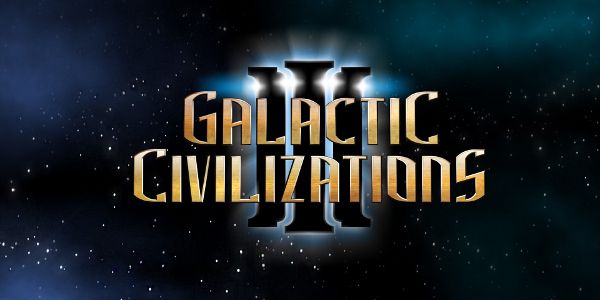

Iconians
Tough difficulty, Genius AIs
Standard Galaxy, 6 Opponents, No Tech Trading
GC3 version 1.03
Livestream Links: Part One | Part Two
This is a writeup of one of my first games from Galactic Civ 3. I think that it was my fourth or fifth game overall; I started out with the Terrans on the default difficulty, and spent about six hours on the release weekend just trying to understand how the mechanics worked. Then I played a full game with the Altarians, again on Normal difficulty, where I fooled around with the Influence mechanics and won a victory by culture-pushing the rest of the galaxy into oblivion. I streamed that game in full; go ahead and follow this link if you're interested in watching. After that, I increased the difficulty to Challenging/Gifted and started a Livestream game with the Krynn, which I did not finish, and played an offline game with the Terrans, which I did finish with an Alliance victory. In both cases, I found myself pulling away from the AI empires after the first 50 turns. The AI simply did not receive enough bonuses at that level to remain competitive with a skilled human player who understood the game mechanics. Maybe the AI will get better with time, I don't know. In this early stage of the post-release period, Challenging difficulty was nowhere near hard enough.
For this game, I would be dialing things up to Tough difficulty with Genius AIs, the second-highest setting in each category. This would also be the first game that I played on the version 1.03 patch, which fixed a few glaring balance issues from the initial release (while still leaving many others untouched). GC3 does so many things well that the poorly balanced parts of the gameplay stand out - and unfortunately, right now there are a few things that are REALLY badly unbalanced (sensors, carriers, planetary invasions, some of the custom race options, etc.) There are also persistent interface problems that are a source of constant annoyance, especially related to the planetary management screen and the research screen. Why do I have to turn off "auto-upgrade improvements" on every single planet individually? Why does research overflow work in such a weird way? Why can't I see the actual cost of each tech in beakers??? I still wonder why Stardock didn't hold onto this game for another month or two of polishing before the official release. The game certainly would have benefited from more development, and I can't believe it was that important to release a game in mid-May, months away from any major holidays. Who knows.
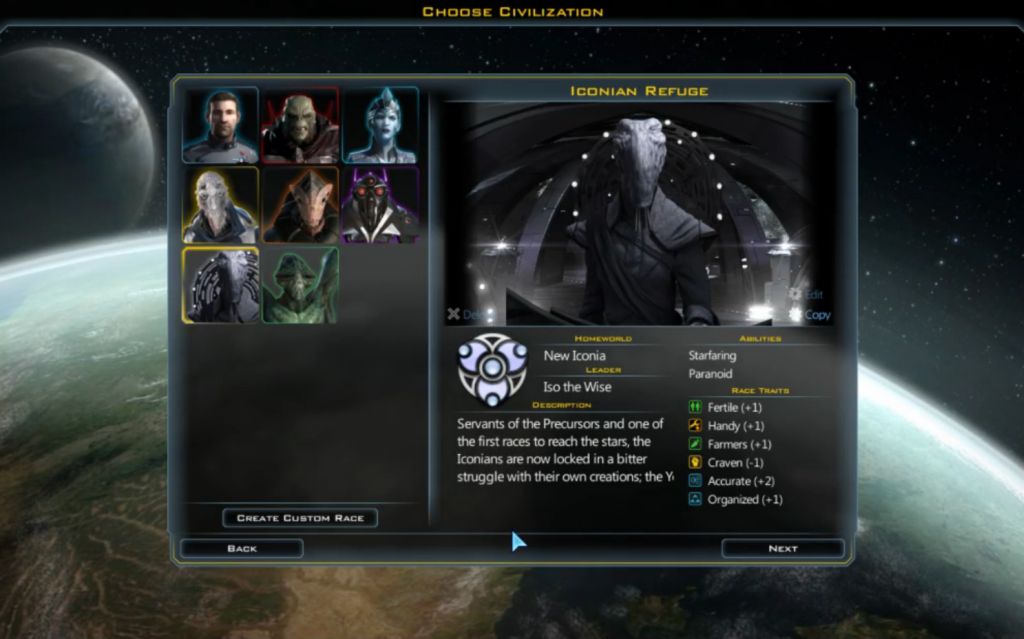
Anyway, I decided to play on a Standard sized galaxy and add in 6 random AI opponents. (This was the first patch where GC3 allowed for random opponents - yes, the game actually released without that option!) I wanted a more crowded map to force competition for planets, and I hoped that more AI opponents would lead to some interesting diplomacy. I kept tech trading off, as I had done for all previous games. I don't ever expect to turn on tech trading in GC3. I know exactly where that gameplay leads, we did the whole tech brokering thing back in Civ3, and I have no desire to experience it again. GC3 is a far better balanced and more interesting game when the player has to do his or her own research.
For this game, I would be playing as the Iconians. They have a strange mix of traits; the Iconians are the game's farming race, with bonuses to growth and food. These are not the same thing in GC3: growth affects how quickly the population on each colony increases, while food affects how many people can survive on each colony. Think of the food stat as a population cap, essentially. If the food of a planet is 10, that's how many people the colony can have as a maximum. So the Iconians grow quickly (well, slightly more quickly, no one grows fast in this game) and they can have larger colonies when they max out eventually. Space farmers. This racial trait is bizarrely paired with piloting abilities; the Iconians can travel through hostile space environments without penalty, and their pilots get an accuracy bonus in combat. Finally, they also get a nice +15% manufacturing bonus as well. These guys are like a weird mix of the Sakkra, Alkari, and Meklars from Master of Orion. From what I can tell, the Iconians look like a decent race without being top tier. I would take them for a spin here and see what happened.
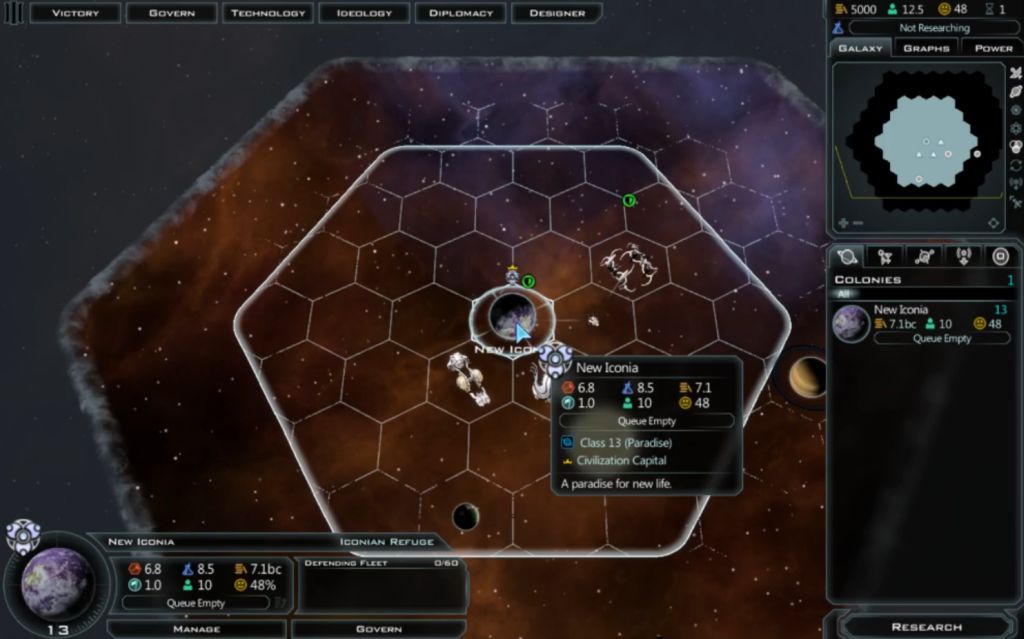
Since this is the first writeup I've done for GC3, I'll try to explain the opening moves in some detail. I think that I've got the typical opening pattern down by now, at least for the settings that I'm likely to use (smallish maps and no tech trading). This is the screen that opens up every new game of GC3. The player always begins with a home planet, a shipyard (the structure off to the right of my homeworld - ships are constructed in space in this game), and three initial ships. You always begin with a colony ship, an unarmed Tiny scout ship, and a Medium survey ship which has light weapons and can explore "anomalies", this game's version of the Civilization tribal villages. Ships must have a survey module in order to loot these goodies, so your little scout can't make use of them. Only the survey ship. You have vision five tiles away from your homeworld, and everything else in the galaxy is a sea of gray fog.
I highlighted New Iconia to show the starting stats for the planet. Different races begin with different starting systems, which is one of the neat little aspects of GC3. The Iconians start with a class 13 planet and a little class 3 planet in the same system. The Krynn begin with a weaker home world (I think it's class 9 to start?) but they have two other small planets to colonize in the same system. The Thalans have a class 16 homeworld and no other planets in the starting system at all. It makes for some nice versatility. As for planet class, that refers to how many tiles are available for building improvements down on the planet's surface. We'll look at that in more detail in a minute. Planet class (PC) is easy to understand: higher is always better. The PC3 world next to New Iconia is an extremely weak location, barely able to support life at all. It's questionable as to whether it's even worth colonizing. Of course, there's only so many planets in the galaxy - this is not like Civilization where you can settle anywhere - which makes even the crummiest locales worth having, eventually anyway. Better your empire than someone else's. For this game, I wouldn't be sending the starting colony ship to the nearby world, but I planned to grab it down the road.
The six icons shown when hovering over a planet are production (red), research (blue), credits/money (gold), then on the second row, the influence level (light blue), the current population (green), and the planet's morale (smiley face). You always start the game with a population of 10 on the homeworld, which is the current population cap on New Iconia. We can't grow any more until we construct improvements or research technology that adds additional food. (Remember food = population cap in this game. Food has nothing to do with growth rate.) The colonies tab on the right side of the screen provides a short summary of this information, unfortunately not customizable on what displays. (I wish that I could remove the credits/money part and replace it with research, since that would make it much easier to identify which planets are currently doing research. Ah well, maybe eventually.) Of course there's more information on all this under the Govern panel at the top of the screen. There's also a minimap on the right side, which can be customized with different display options in a very nice touch, and above that, at the top of the screen, the current empire-wide money total, population total, and morale level. Note that GC3 starts the player with 5000 credits (!) to begin. Why does the game do this? I have no idea! It's one of the stranger design decisions I can think of, since it allows the player to ignore the budget entirely for the first 50 or so turns of the game. And GC3 allows the player to rush-buy anything they want right from the start, with no limitations beyond the money in the treasury. This means that the opening turns in GC3 are largely about leveraging those 5000 credits into magical rush-buys that will speed up the growth curve as much as possible. The gameplay would be much stronger and more interesting if the player had to build these things the hard way, making difficult decisions along the way, rather than seeing them appear out of thin air. But that's the game that we have, so you might as well make the most of that starting income.
Let's look at the homeworld in more detail. You might have noticed that New Iconia seemed to be splitting its income evenly between production, research, and credits. That's the default starting configuration in GC3:
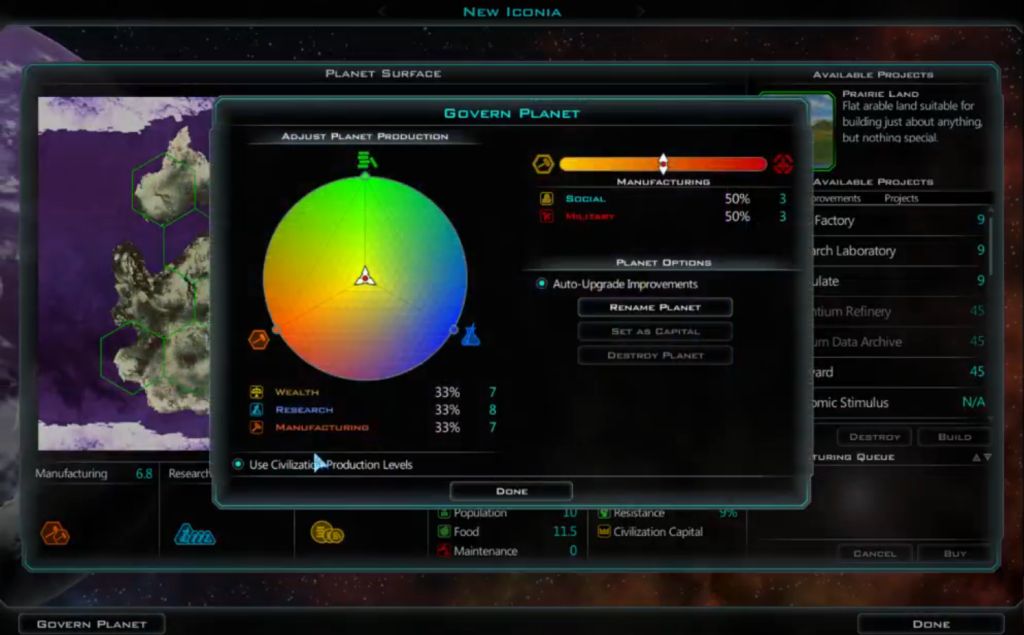
Here are the sliders on the Govern Planet screen. Get used to seeing this display, you'll be spending a lot of time here if you wind up playing GC3. The economic model in this game is similar to Master of Orion, where each planet has a certain amount of income that can be spent each turn, and then you choose where to allocate it. Like in MOO, there's no separation between research and production: research = production = money on the sliders. You can pick whatever percentages you want on that three-way colored wheel thing. Unlike in MOO, these percentages are modified by the buildings constructed on each planet, which tends to lead towards heavy specialization of planets. Master of Orion had a little bit of this, but only in the Rich/Poor/Artifacts setup. In GC3, you can tailor any planet towards a particular focus depending on how you develop its tiles, and planets themselves start with natural bonuses and penalties as well. There's a lot of room for customization and experimentation here.
Anyway, the starting configuration is 33% slider spending in each of the three fields. Let me start this clearly: this setup is absolutely terrible. Do not ever set the sliders this way.  As in most strategy games, trying to do a little bit of several things at once is a recipe for disaster. You want to be going 100% full steam ahead into one field, and only splitting income in very rare exceptions. The fact that the AI always tries to split its planetary income into three directions at once is a major reason why it struggles so badly in this game. At the beginning of the game, you want either 100% production focus to build terrain improvements / spaceships, or you want 100% research to push towards a key tech. Always one or the other. Money is irrelevant due to starting with 5000 credits in the bank. Make sure to turn off "Use Civilization Production Levels" and "Auto-Upgrade Improvements". To play the game well, you'll want to manage each colony individually, and you'll want to control when and how improvements get upgraded. Do not trust the AI automation to handle this for you.
As in most strategy games, trying to do a little bit of several things at once is a recipe for disaster. You want to be going 100% full steam ahead into one field, and only splitting income in very rare exceptions. The fact that the AI always tries to split its planetary income into three directions at once is a major reason why it struggles so badly in this game. At the beginning of the game, you want either 100% production focus to build terrain improvements / spaceships, or you want 100% research to push towards a key tech. Always one or the other. Money is irrelevant due to starting with 5000 credits in the bank. Make sure to turn off "Use Civilization Production Levels" and "Auto-Upgrade Improvements". To play the game well, you'll want to manage each colony individually, and you'll want to control when and how improvements get upgraded. Do not trust the AI automation to handle this for you.
On the right side of the screen, there's another slider for Manufacturing, which can be split between Social and Military. This slider simply allocates where the production is going, either onto the planet itself to build improvements or out into space to build ships in the shipyard. As you've probably guessed by now, the vast majority of the time this will be either 100% social or 100% military. Splitting your production between the two options is highly inefficient. Decide what you need the most and head there as fast as possible.
Now let's look at the surface of New Iconia itself:
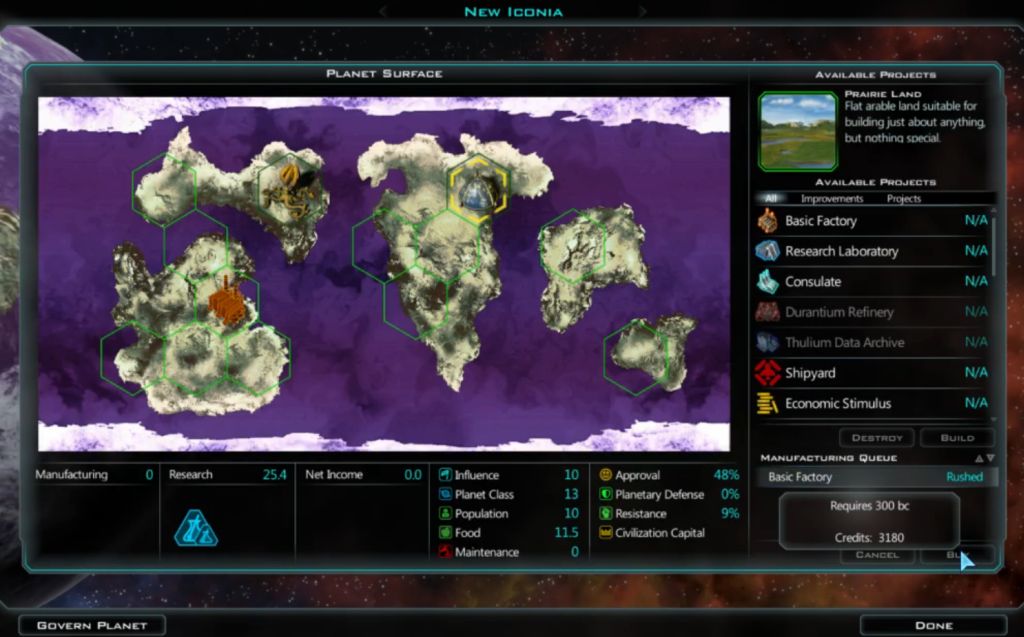
This is the main planetary screen, much like the city screen in a Civilization game. The little green hexagons indicate where improvements can be built on the surface of the planet. This is where we finally see what it means to be Planet Class 13: there are 13 available tiles that we can use. One of them will always be taken up with the colonial capital (the gray building in the center) and there's a resource on another tile to the west. You can destroy the resources if desired, but they provide minor empire-wide benefits, so that's usually not a good idea. That still leaves 11 open tiles to build upon, and we can use them to customize New Iconia however we want.
The choice of what to build on those tiles is listed at the right side of the screen. At the start of the game, we can build factories (production), research labs (research duh), or consulates (influence/culture). Throughout the game, many more types of buildings are unlocked with the discovery of additional technology. Most of the buildings have no limit to how many can be constructed on each planet; this is not like Civilization where you construct 1 factory per city, you can build as many factories as you want! The clever thing about GC3 is that buildings can only be placed on available tiles, however, so any building that gets constructed comes at the cost of putting something else down on that tile. Buildings will also get bonuses depending on where they're constructed; some terrain will naturally favor certain types of buildings. (Unfortunately there are no examples of this on the homeworld.) And buildings also receive bonuses for being placed next to similar buildings; for example, grouping factories together will increase the production bonus that they provide. This leads to some fun SimCity possibilities. Every planet will have a different configuration of continents and oceans, the available tiles won't always be where you want them, and the terraforming that comes with additional technology can open up more tiles later in the game. The whole system is a real winner and has surprising amounts of depth to it.
One of the lessons that new players often don't pick up on right away is that there's no benefit to leaving tiles unused. Buildings are pretty cheap in this game (at least the early ones), and you can always tear something down and replace it later if you change your mind. Plus terraforming will give you more tiles to use later on anyway. The right decision is to get your buildings down ASAP to start taking advantage of their benefits. This is another failing of the AI: it will be running 33% production on the sliders, and then that gets further cut in half by sending 50% of that to shipbuilding. How long do you think it will take to get your infrastructure done if you're only spending 1/6 of your income on it? Do not imitate the AI! Instead, new planets typically want 100% production and 100% social spending, to get those buildings rushed out immediately. This is the best way to accelerate your growth curve.
The homeworld is a special case, of course, since it's the only planet that the player has at the start of the game. I've found that it's almost always best to specialize the homeworld for production, since you'll need to be churning out colony ships and constructors from that starting shipyard. It's better to use the second planet for research, if possible. That means getting some factories out immediately at the start of the game, and at first I tried having the homeworld build a few of them, which take 2 turns each to begin. However, I've since found this to be suboptimal. Instead, it's better to rush-buy factories for the first few turns, which cost a paltry 300 credits each. Remember, you start with 5000 credits, might as well put them to use. This then frees up the homeworld to do research for the initial few turns while those factories are being rush-bought. There's one tech in particular (Interstellar Travel) that you'll want to get immediately, and these first couple turns are the perfect time to do that.
There's one other thing that I will typically do on the first turn, and that's to design a sensor ship:
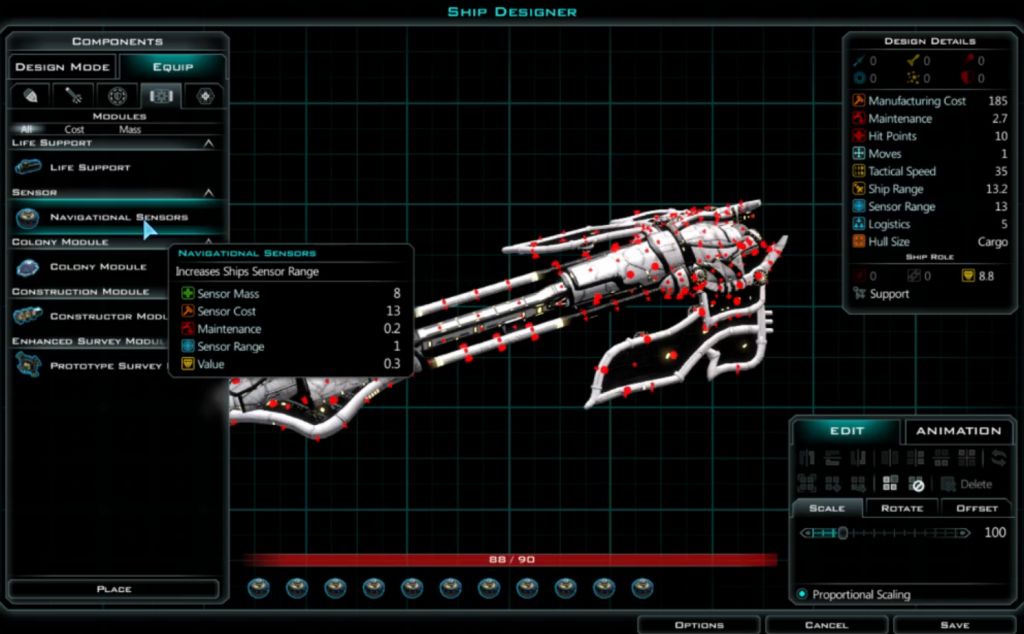
This is a picture of the ship design screen. You design your own ships in GC3, just as in Master of Orion, or it's possible to use the designs that the AI suggests. (Protip: do not use the AI designs. They suck.) While this screen can be a bit intimidating at first, it becomes easy enough to understand after a little while of playing around with the options. First the player will be asked to pick a hull size; this determines how many hit points and hull space will be available for the design. At the start of the game, there are only two of them available: Tiny and Cargo. Tiny ships only have 25 hull space available, to go along with 25 HP. The Cargo designs have 90 hull space available, but they only have 10 HP. They are intended to be used for colony ships, trade freighters, that sort of thing. You can put weapons on them if you want, but with only 10 HP they won't last long in a fight. Larger hull sizes are of course unlocked with more technology. Since there are limits on how many ships can be stacked together, in this game bigger hulls are always better (if more expensive).
I've used a Cargo design for my sensor ship setup. GC3 currently places no limits on what can be put on a ship. This is one of the biggest balance problems in the game right now, as there really should be either a hard cap or diminishing returns on some of the systems that can go onto these designs. In the lategame, players can stack engines on transport ships to get ridiculously fast invasions, moving 30 tiles or more across the galactic map to capture planets. It's pretty broken from what I understand...  Here in the early game, I'm exploiting the ability to stack sensors on a Cargo hull. Each one takes up 8 hull space and allows the ship to see 1 tile further away. I can put 12 of them on the ship and have the ability to see 13 tiles away. If that sounds silly, this is actually post-nerf of the sensors; in the 1.00 version of the game, this same ship would have been able to see about 20 tiles away! Now there are limitations to this design, of course. This ship has no weapons, no defenses, no range upgrades, and moves 1 tile per turn. But does that really matter? The goal is to see everything around my homeworld immediately, ideally to spot colonizable planets and start pushing for them right away. The ability to get "map hacks" from a sensor ship is a priceless advantage. I will invest 2000 credits into rush-buying one of these immediately from the shipyard, and then on Turn 2, the local galactic neighborhood will suddenly be revealed.
Here in the early game, I'm exploiting the ability to stack sensors on a Cargo hull. Each one takes up 8 hull space and allows the ship to see 1 tile further away. I can put 12 of them on the ship and have the ability to see 13 tiles away. If that sounds silly, this is actually post-nerf of the sensors; in the 1.00 version of the game, this same ship would have been able to see about 20 tiles away! Now there are limitations to this design, of course. This ship has no weapons, no defenses, no range upgrades, and moves 1 tile per turn. But does that really matter? The goal is to see everything around my homeworld immediately, ideally to spot colonizable planets and start pushing for them right away. The ability to get "map hacks" from a sensor ship is a priceless advantage. I will invest 2000 credits into rush-buying one of these immediately from the shipyard, and then on Turn 2, the local galactic neighborhood will suddenly be revealed.
I don't feel guilty about using this because on the top difficulty levels the AIs all cheat and start with a fully revealed map. They can see exactly where all the planets are located and beeline their colony ships there on the first turn of the game. This is one bonus that I truly do begrudge them; the AI should have to scout out the map to colonize planets. The current setup is wildly unfair. If the AI is going to use map hacks, then so will I.

Here's what things looked like the next turn, with the sensor ship magically completed in the shipyard. The extended vision revealed a pair of planets to the east in the Yoloswagulus cluster (the designers had a sense of humor with their names). PC10 and PC11, both with nice innate bonus features! I sent my starting colony ship to the PC11 and planned to send a second ship as soon as I could construct one. I probably should have rush-bought a stripped down colony ship here, you can take out everything but the colony module and make them pretty cheap. Something to keep in mind for the next game. There wasn't much else of interest in the immediate vicinity, some asteroids to the north and a pair of Durantium resources (the red icons) off to the west. I would need to do more exploring.
Note that Interstellar Travel has a turn invested into its research. It normally takes 3 turns to research that tech at the start of the game, and I believe tech costs currently do not scale with map size. (An interesting design decision.) Two additional turns later, the tech finished:

OK, what makes this the key first tech to research in GC3? Let me back up and explain a little bit about how the tech tree works in general. GC3 technically has four different tech trees, which are broadly grouped into Planetology, Engineering, Military, and Diplomacy. The first Planetology tree covers upgrades to factories, research labs, farms/hospitals, terraforming, and the ability to colonize planets with hostile environments. It's incredibly important and I tend to prioritize it the most. The second Engineering tree covers ship engines, ship range, sensors, hull size, and all of the mining stuff associated with starbases. The third Military tree covers, well, military techs: weapons, defenses, invasions, etc. You actually start the game without any weapons at all! The final tree covers a mixture of different things: diplomacy, influence, morale, trade, markets, etc. Broadly spreaking, the first and last trees tend to be the economic ones, while the second and third trees are the shipbuilding/military ones.
All of the trees operate on the same basic principle. They start out with cheap techs that do a lot of different things at once, and then as you progress further down the branches, the techs become more and more specialized as they get more expensive. For example, one of the first Planetology techs is called "Planetary Improvement". It opens up the tier 1 farm, the tier 1 hospital, and the tier 1 terraforming (ability to build on 1 additional tile). If you go deeper into the tree, the tier 2 farm, the tier 2 hospital, and the tier 2 terraforming all have their own separate techs. The deeper that you go, the more specialized things get. Therefore it's typically best to get the basic techs for everything, since they're cheap and provide a lot of benefits. Of course, specializing in one area can be extremely powerful as well, if your empire does one thing heads and shoulders better than everyone else. There's certainly no shortage of options to pick between; there's about 300 techs in total!
Interstellar Travel is an extraordinarily useful tech because it unlocks four different important things all at once. First of all, it grants +1 moves to all ships, forever. This is hugely useful in the early turns of the game when exploring the map and racing colony ships to their destinations. My sensor ship doubled in moves from 1 to 2, for example. The tech also unlocks the tier 2 versions of engines, life support, and sensors. Engines affect how fast your ships move on the galactic map, and there's no limit to how many can be put on a ship beyond the hull space available. The default engine provides +1 movement for 10 hull space. The tier 2 engine provides +2 moves for 12 hull space, an absolutely massive improvement. Watch and see how I use speed to my advantage further down on this page. Life support refers to the range of your ships, how far they can travel from your nearest planet or starbase. Their tier 2 version doesn't even cost more mass (it's 6 hull space for both tier 1 and tier 2), it simply increases the range of your ships. Very useful to have, especially for constructors or trade ships that need to travel far from home. Finally, Interstellar Travel tech also unlocks the tier 2 sensors. Instead of costing 8 hull space for +1 vision, the tier 2 sensor costs 9 hull space for +2 vision. Once again, the benefits are obvious. As soon as this tech completed, I would redesign my sensor ship with the new tier 2 systems. I had to remove one sensor unit because of the higher mass, but I would reshape the ship with eight tier 2 sensors (vision 18 tiles away) along with a tier 2 engine for 4 moves and a tier 2 life support for the additional range. I upgraded the old sensor design into the new one for a cost of 400 credits, and then I was off and running with the new ship. Naturally all my new colony ship designs would also make use of this new starfaring technology.
I feel that Interstellar Travel needs to be the first tech researched in virtually every game. The advantages it offers for moving around the map are simply too big to ignore. The early turns of GC3 are all about identifying planets to colonize and then getting there as fast as possible. Interstellar Travels makes doing that far, far easier.
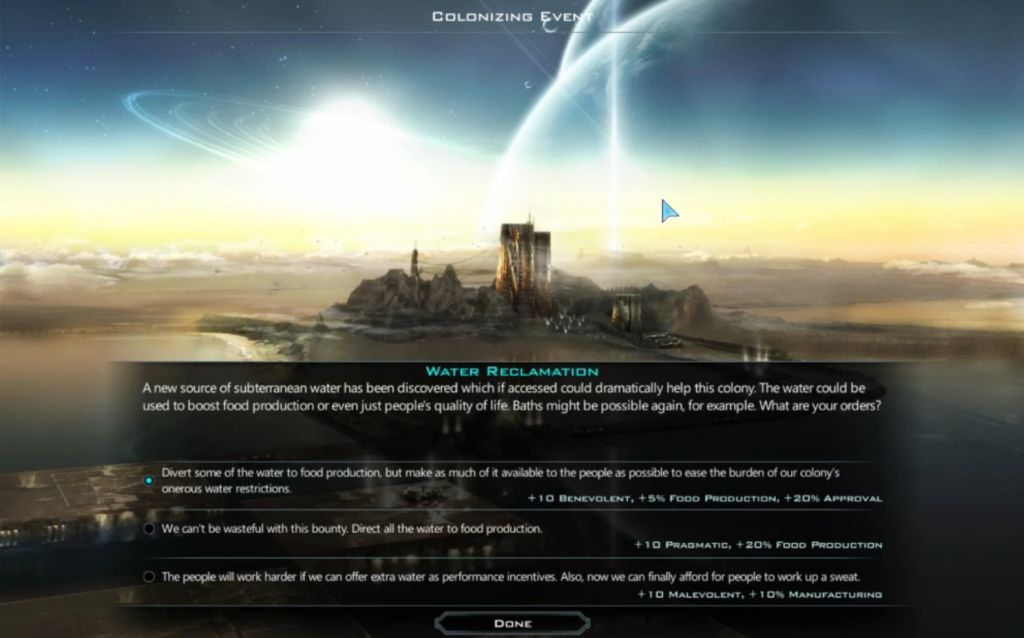
When I colonized Yoloswagulus, I was prompted with this event. These morality options have been a part of the series since the first game, and they typically offer the player a choice between different benefits or different penalties. Here all of the options are good ones, but that's not always the case. Unlike in past Galactic Civ games, the choices made when colonizing planets are now tied to an Ideology system that should look awfully familiar to veterans of Civ5:
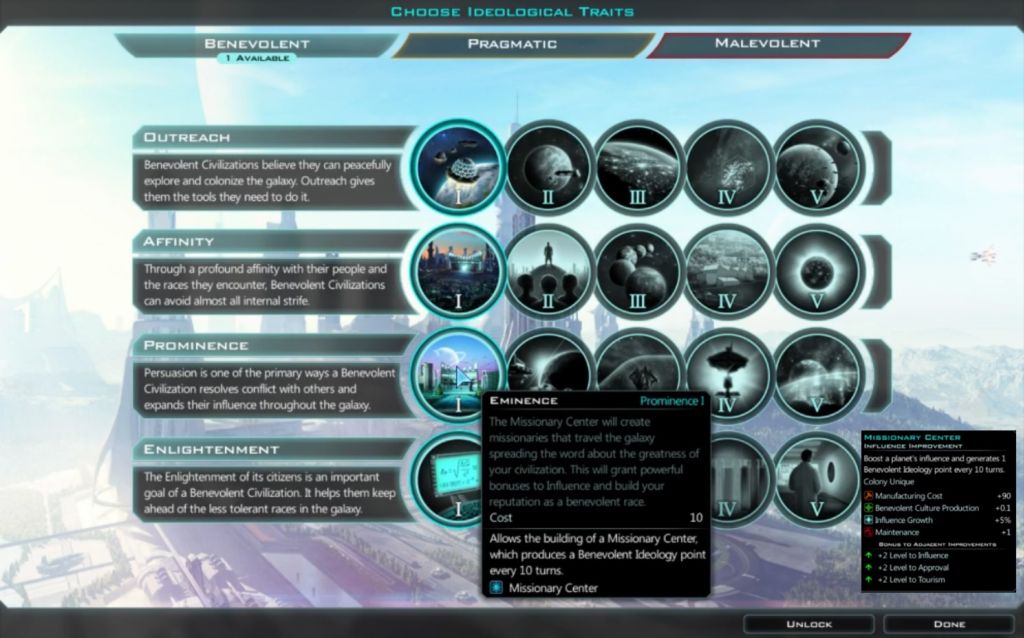
Social policies anyone? Choosing the Benevolent, Pragmatic, or Malevolent options in the event dialogues will grant the players points that can be used to unlock policies in each of the corresponding ideologies. This is the Benevolent ideology here, there's an additional screen for each of the Pragmatic and Malevolent ideologies as well. You can mix and match taking policies from the different ideologies, but you probably won't want to do so since the best policies are the ones that are deepest into their respective trees. The AI will be friendly with empires that share the same Ideology, and hostile towards those with different ones. I generally like this gameplay system, although ironically it tends to undercut the event options somewhat by tying them to the ideologies. Even if the Malevolent option is a poor choice, you'll almost certainly take it when playing a Malevolent game simply because you want those points towards the next policy. Overall though, this is pretty cool. I've always said that the social policies were the single best gameplay idea in Civ5, and tying that system to the traditional morality events in GC3 feels like a good fit.
I'm still learning the ins and outs of the different Ideologies at this point. My first impression is that I like both Benevolent and Malevolent more than Pragmatic. Yes, I know that Pragmatic has that whole "get 3 free constructors and upgrade them into colony ships" trick, it's not nearly as strong as many people on the forums believe. Colony ships are cheap to build, it's finding available planets to send them to and getting them there ahead of the AI that's the problem. (At least on the maps that I play, maybe not on those silly gigantic maps with hundreds and hundreds of worlds.) I took the Benevolent option at Yoloswagulus and I would be pursuing a Benevolent path for this game. The Benevolent tree has some nice policies available; the Outreach line provides a free colony ship and eventually a free "undiscovered" planet next to your homeworld, the Affinity line has a bunch of morale bonuses, the Prominence line is full of influence bonuses, and the Enlightenment line has research stuff. Sadly Englightenment is not as good as it sounds, at least not until reaching the fifth and final policy there, but I like the other three a lot.
I selected the first Prominence policy because it unlocked the missionary center improvement. One of these can be built on each planet, and each one provides 0.1 Benevolent ideology points per turn. With enough planets, you can put down a bunch of missionary centers and continuing progressing towards more Benevolent policies. (The first policy costs 10 points, then 20, then 30, etc. The event dialogues from colonizing planets are worth 10 points. Note that this whole system completely falls apart on immense maps where players are colonizing 30, 50, 100+ planets.) Of course the missionary center does take up a tile, so that has to be kept in mind. The missionary center also grants +2 building levels when placed next to influence buildings and morale buildings, the latter of which is a very nice perk indeed. I would pair these next to morale buildings on many of my planets.
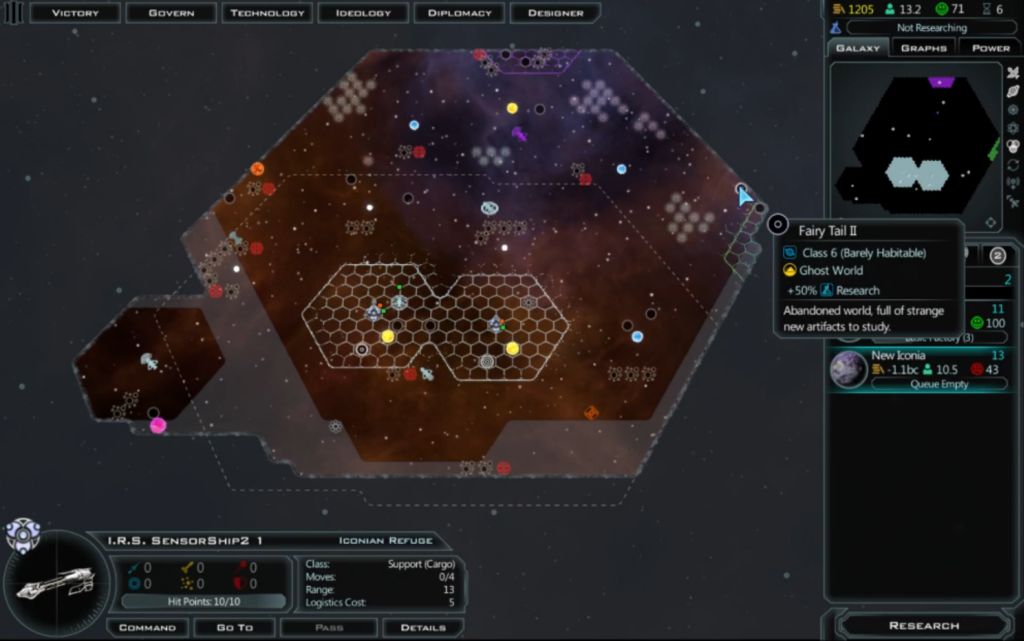
This was the map in the aftermath of colonizing Yoloswagulus. With the upgraded sensor ship, I could see even further away, enough to spot two nearby AI empires. The Yor were located to my north; those were the borders of their home system visible at the top of the screen. Over to the east, I could see the borders of the Thalans in green even though I hadn't met them yet. There's also a planet visible over there, but I seriously doubted that I would have any chance to grab that little PC6 world before the Thalans made it their own. I've also found a nice resource cluster to the west with two Durantium and a Thulium resource, and a production relic (the orange diamond icon) to the southeast. These would make good targets for later starbase construction. By the way, this is how I spend most of my time playing GC3, with the map zoomed out just far enough to see the icons for everything. While I like the artwork for this game up close, it's far more practical to play the game at this zoom level. The ships can be hard to see when they aren't turned into icons. Once you know what the icons mean, it's easy to understand what's going on. The white dotted line shows the range where my sensor ship can travel, 13 tiles at present. To go further, I'll need either more colonies, more starbases, or a different design with additional life support.
Here's a peek inside the homeworld:
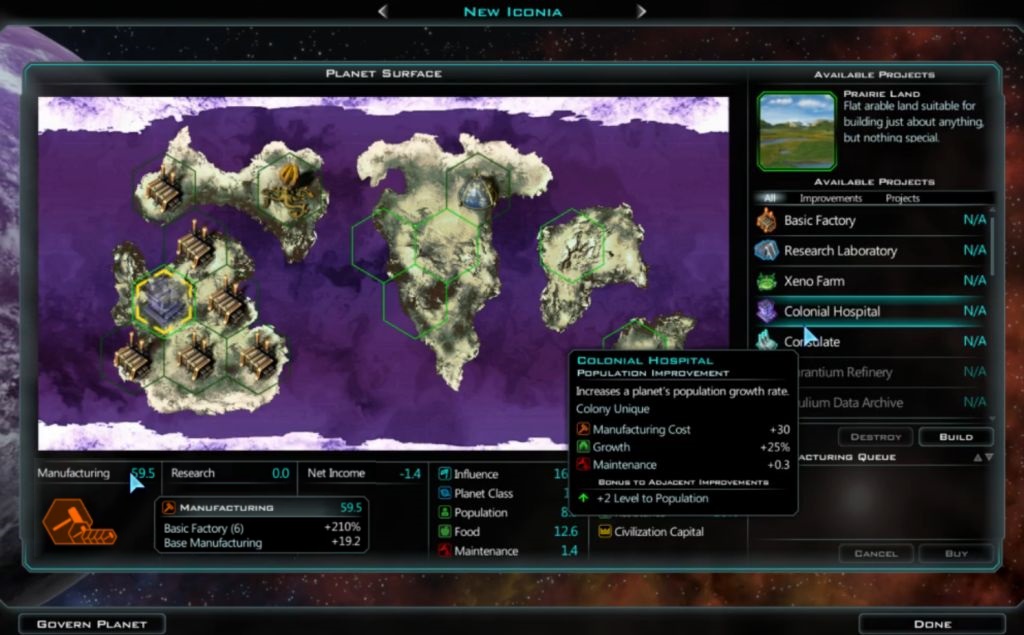
I've been rush buying factories every turn while having New Iconia do research. Thus far, I had managed to fill out that whole little island in the west with factories; the one open tile in the center will be used for a Durantium Refinery once I have a source of the resource. This is probably a good time to discuss the economic system of GC3 in more detail - that is, where are all these numbers coming from? Each planet receives a base amount of income each turn, that's the 19.2 number in the picture above. There's a certain small amount that comes from the colonial capital, and there are a few technologies and ideologies that can increase the base number. However, the bulk of your base income is derived from the planet's population. The higher your population, the higher the base income of the colony. This makes population an incredibly important number: with more of it, your planet gets better at doing literally everything! Growing your planets as fast as possible is therefore hugely important to the economic side of GC3.
Once that base income is established, the number is run through the slider settings (production/research/money) and whatever modifiers are present for the colony. In this case, the sliders can be ignored because New Iconia is running 100% production. Because the colony has a whole bunch of factories, New Iconia picks up a bonus of 210% to its production and reaches a total of 59.5 hammers per turn, a nice total for this early in the game. This is the general rule for GC3: buildings provide percentage modifiers. They almost never increase the base income. For example, the basic factory increases production by 25%. You can put as many of them on a planet as you want and keep increasing that percentage bonus, at least until you run out of tiles. But wait - there are six factories here, shouldn't that bonus be 150% and not 210%? That's where the building adjacency bonuses come in. Because the factories are all sitting next to each other, they're providing bonus building levels for additional production. It's 5% extra production per level, so that factory at the top gets one bonus level for being next to another factory, 5% extra production for 30% total. The next one down is adjacent to two factories, for 10% extra production or 35% total. Add them all up to get 12 bonuses at 5% each = 60% bonus production, just as expected. Figuring out where to place the buildings can be a lot of fun, and the benefits are not trivial at all. Without all the adjacency bonuses, New Iconia would only have 48 production per turn.
OK, so it's important to increase the population of your worlds to improve their base income, and then that number gets run through the percentage modifiers added by the buildings. How do you speed up the growth rate? Well, one of the few ways to do so is to construct a hospital improvement. Hospitals are a unique building (only one per planet) that improve the growth rate. The tier 1 version highlighted here improves it by 25%, and no, I won't be placing it in the middle of all those factories! Hospitals also provide an adjacency bonus to farms (remember farms increase the population cap of planets), and farms provide a bonus back to hospitals. I strongly suggest putting a hospital/farm pair together on every world, since they tend to reinforce one another. Hospitals are critically important to get your planets growing faster, and you don't start the game with them - I've already researched their tech after finishing Interstellar Travel. The tier 2 hospitals improve growth by 50%, and the tier 3 ones improve it by 100%. Both are nice techs to pick up down the road. In short, research to hospitals and get one up quickly on all of your planets. Growth is simply too slow without them.
The second and even more important component to growth is morale. Right now, the morale is mediocre to poor on New Iconia, and that's slowing down growth compared to where it could be. I'll come back to morale in a little bit to explain further.
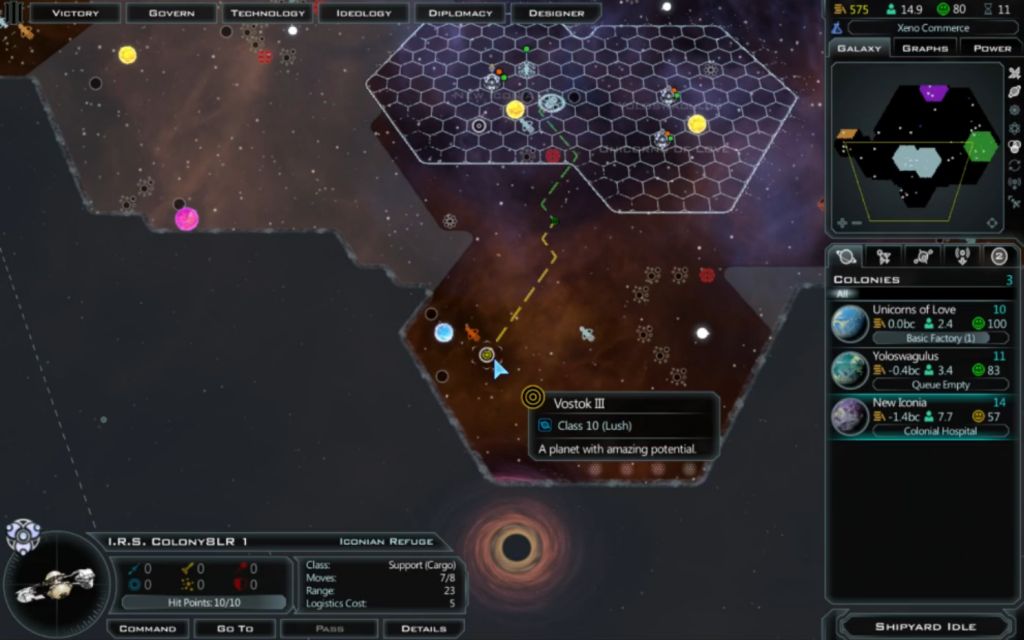
Here's the map from a few turns later, on Turn 11. After finishing those six factories, I put New Iconia onto colony ship construction and cranked out a ship for the other planet in the Yoloswagulus system. With range being no concern, I was able to design a colony ship with 10 movement and grab the other planet on the very turn that it popped out of the shipyard. No wasted turns! Once of the Livestream viewers requested the name Unicorns of Love after the professional League of Legends team, and I went with it. I would later decide to specialize both of these strong planets for research, providing the core of the economic engine for my empire.
To the south, my initial tiny scout ship (which I redesigned and upgraded to have additional sensors) has found another good planet, PC10. There's another colony ship already on the way down there, this design needing a life support module for additional range but still having 8 moves. I've named it Colony8LR to indicate the number of moves and the long range due to the life support. Note that there's an orange ship nearby; that's a Krynn scout ship. This planet was very close to their borders, however I was able to swoop in and steal it before they could arrive. Very nice indeed. I'll also point out just how FAST the early game moves in GC3. I spent the first six turns rush buying factories on the homeworld while researching the first two techs. Then I swapped over to colony ship production, churning them out at a 2 turn rate on Turn 9 and Turn 11. In the first dozen turns, the homeworld has finished its core infrastructure, we've built a sensor ship and two colony ships, we'll have four planets colonized, and two techs already researched. This isn't the snoozefest of Civ5's early game! 
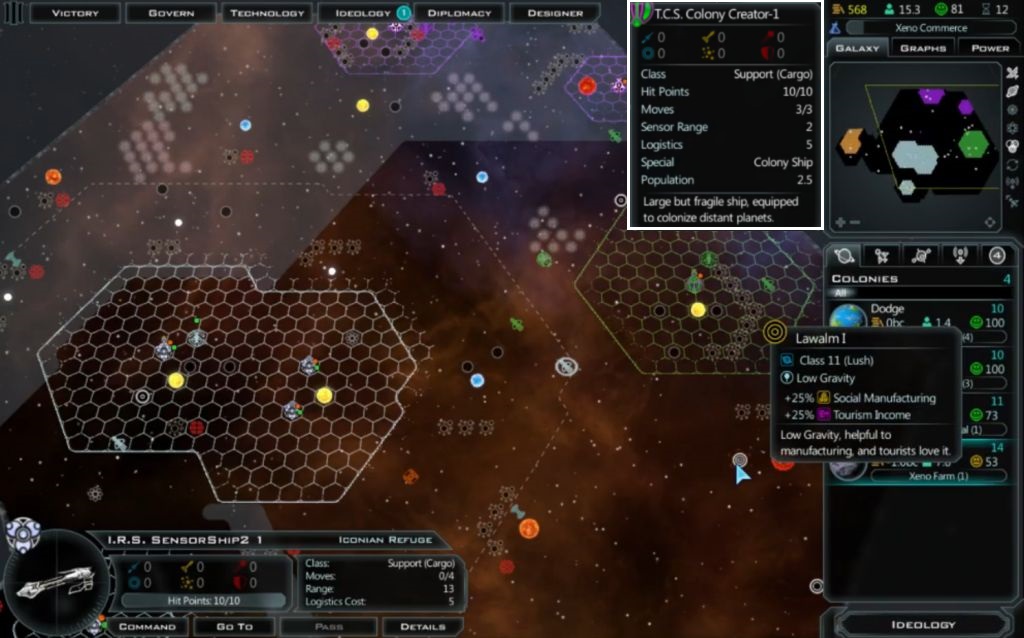
Check this out. On the next turn my sensor ship spotted a pair of uncolonized worlds over to the east near Thalan space. The highlighted planet was by far the better of the two, PC11 with bonues to social manufacturing (how fast improvements get built) and tourism. The other planet almost cut off the screen in the southeast was only PC6, and so far away on range that I'd have to cut a whole bunch of engine speed to get over there. No, if I was going to get a colony in this region, it was going to have to be that PC11 world. Could I beat the Thalans to the punch? I counted out the number of tiles and discovered that I could just barely make it to that spot with my current Colony8LR ship design. By a single tile, I think. (GC3 really needs something on the interface to tell the player "this tile is ____ range from your nearest planet/starbase.") I didn't have the money to rush buy a new colony ship, so it would take me 2 turns to build one and then several turns of transit time to complete the journey. I've highlighted the current Thalan colony ship design at the top of the screen, their ships were only moving at 3 tiles per turn. That might be enough to get there first. Maybe. It was worth the effort in any case. I would try to plant my flag at the PC11 world.
The colony ship finished a couple turns later and headed off to the east. While it was in transit, I spotted this:
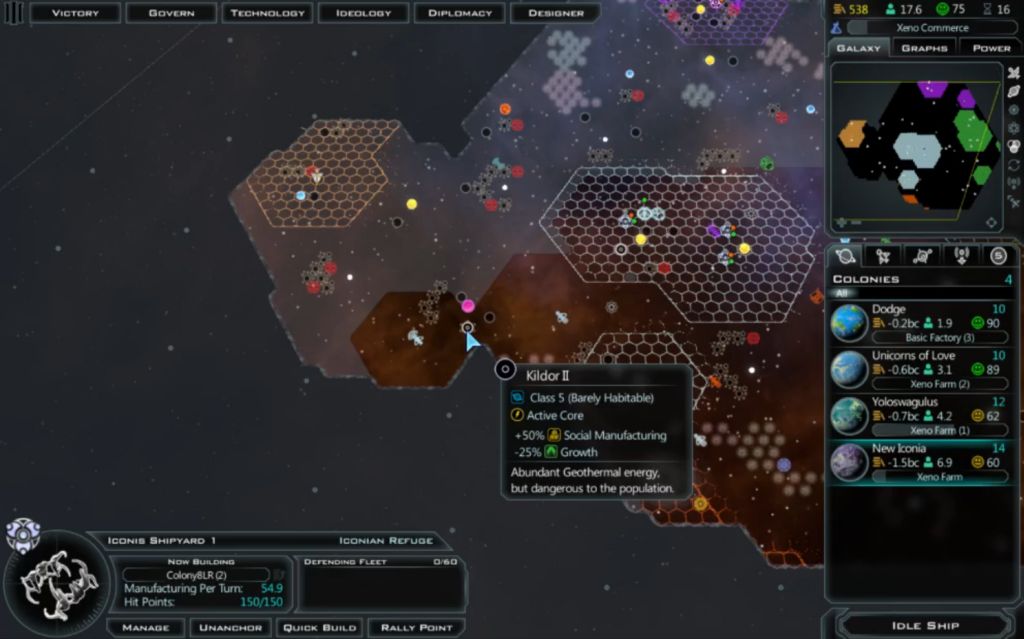
Not much of a planet at only size 5. And -25% growth? Ouch! Still, it was an unclaimed world, and better to have this weak colony than none at all. Or, more likely, a rival empire setting up shop there. With more exploration over the last few turns, it's now possible to see the borders of the Krynn to my south. They were pretty darn close to my new planet in that area, and the Krynn are one of the game's most aggressive races. They're religious fanatics, and they tend to prefer Malevolent ideology, not thinking much of Benevolent practitioners. Could get interesting down there! Meanwhile, the Iridium Corporation wasn't far away either to the northwest, the empire with the light orange borders. My scouting had been weaker in this direction since the sensor ship had gone off to the east. I was fogbusting with the survey ship and the starting little scout, but of course they couldn't reveal the map in the same fashion as my semi-exploitative sensor ship. New Iconia had just completed a constructor for my first starbase, and now I hurriedly needed to push out another colony ship to claim this region to the southwest!
When I met an Altarian ship over in the far east, past Thalan borders, I checked the Diplomacy screen for the first time:

This is your traditional diplomacy matrix, using planets instead of leaderheads as the Civilization series does. Clicking on any of the AI empires will reveal their war status and treaty status with the other empires. Right now, no one has much of anything with the others because it's so early in the game. I can't even talk to the other empires yet; in the Galactic Civ games, the player has to research a tech called Universal Translator to be able to conduct any diplomacy whatsoever. I didn't have that one yet, there were other more important techs to pick up first. As in Civ4, highlighting an AI empire will reveal their attitude towards your civilization. The Altarians liked me because they also prefer Benevolent ideology, and apparently there's also a bonus for being located far away. (Conversely, of course there's a penalty for close borders.) Unlike the Civilization games, you can research techs that increase the diplomatic bonus that you receive with other races. Some of the techs simply grant +1 or +2 diplomacy with all races. This can be very important when pursuing an Alliance victory, this game's version of a diplomatic victory. Unfortunately, while the Altarians liked me, nearly everyone else did not. Benevolent ideology didn't seem to be too popular in this galaxy, especially with my neighbors. I would need to research some diplomatic techs sooner or later to try and rectify this situation. At least no one had gone hostile yet.
According to the faction power rankings, I was currently in third place. I'm quite curious how these rankings get calculated, because later on in the game I was swinging wildly from top of the scoreboard to middle of the scoreboard, and I could not figure out why that was happening. Something with my tech rate, perhaps? The right side of the screen shows how I was first in social manufacturing, which made complete sense. That's the spending done on buildings/tile improvements, which of course I was pushing on every world. Naturally I was lacking in tech power, as the AIs were all running 33% research from the get-go on all of their planets. But once my specialized planets finished their infrastructure, I'd be able to go 100% research and blast right past their inefficient setups. Just need some time for all my developing planets to finishing baking in their ovens. I was also dead last in treasury (of course! spend that money, don't sit on it!) and last in morale. The AI cheats outrageously on morale at the higher difficulty levels, while the player is given no such edge. After the initial round of colonization finished, solving the morale difficulties would be my next top concern. Overall, I was in pretty good shape for this early stage of the game.
To my own surprise, I made it over to the PC11 planet in the far east first:
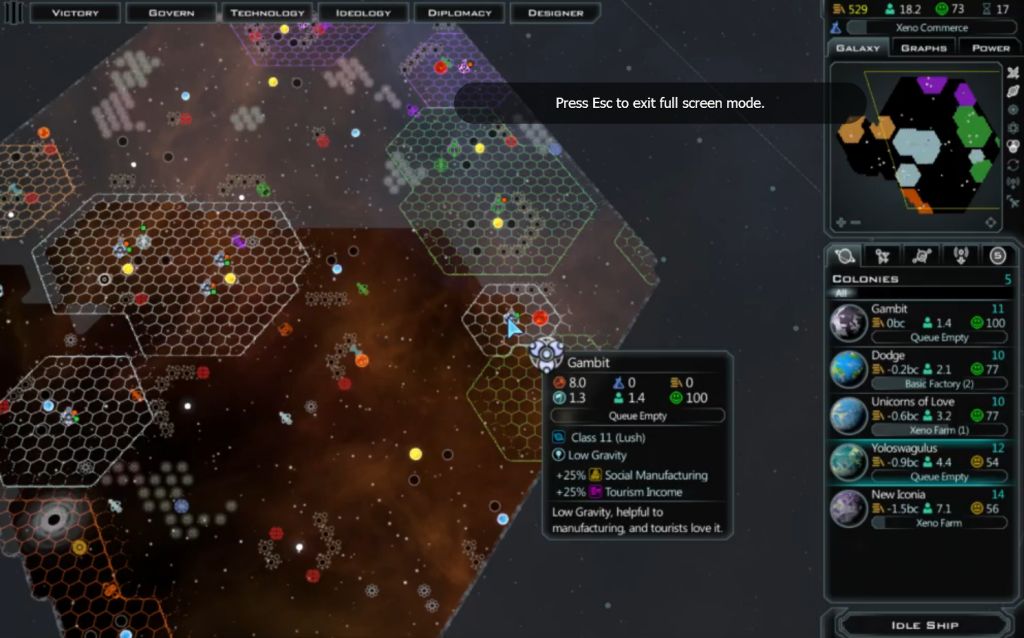
I named this one Gambit, a double reference both to the risky location and the Russian League of Legends pro team. This was the crown jewel of my colonization efforts, a planet that I had no business getting, swiped out from the middle of Thalan space. See the yellow star to the north of Gambit? That was their homeworld, about a dozen tiles away. New Iconia is the western planet in my territory, past the double worlds in the Yoloswagulus system. The Thalans definitely should have claimed this one! For whatever reason, they had sent a colony ship to the weaker PC6 world down to the south first. If they were trying to backfill planets, it had failed miserably here. Due to the tourism bonus and the surrounding Thalan borders, I decided to push influence here with a few consulate buildings. It is indeed possible for planets to culturally flip away to rival empires if they get overwhelmed on influence, and I didn't want to push my luck with Gambit.
By the way, note the huge patch of dead space off to the southeast of my core worlds. I wanted to get a starbase for the production relic, and maybe for the Durantium and Elerium further south, but mostly there was nothing at all in this large region. It was almost like... empty space, heh. That was a bit unfortunate from the random map generation though, as I would have had a good claim on planets in that region. Instead, I would be forced to push into the teeth of the AI empires for everything beyond the initial Yoloswagulus pair.
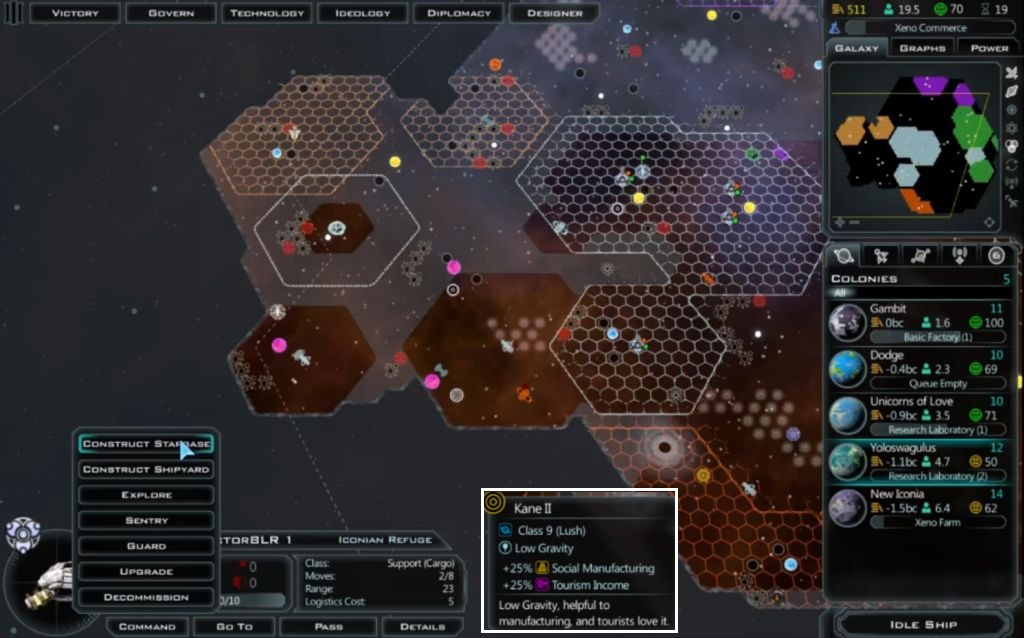
Here's my first constructor about to put down a starbase, so let me introduce that concept briefly. Starbases from the Galactic Civ series are unique entities that don't have any direct comparisons in Civilization or Master of Orion. Starbases are essentially giant space platforms that serve as an extention of your empire in regions of the map that don't have any planets. They grant vision, they produce influence (culture), they can be attacked and destroyed by rival empires, and they serve a variety of other different functions. Starbases are built by ships known as constructors, which are sacrificed in the process of their creation. They're very similar to the work boats from Civ4 in that regard.
The map above shows the potential range of a starbase, five tiles in each direction. This particular starbase was designed to mine the Durantium resources and make them available to my empire. I wanted to put this starbase down in that resource cluster to the northeast, only to find that the Iridium Corp had plopped down their own starbase one turn before my constructor could reach the spot! Now that was annoying. The AI loves to put starbases down all over the place in this game; if there's a resource anywhere on the map, rest assured that they'll try to mine it. If you want to control a region of the map with a starbase, it's important to do so early on before they set up shop.
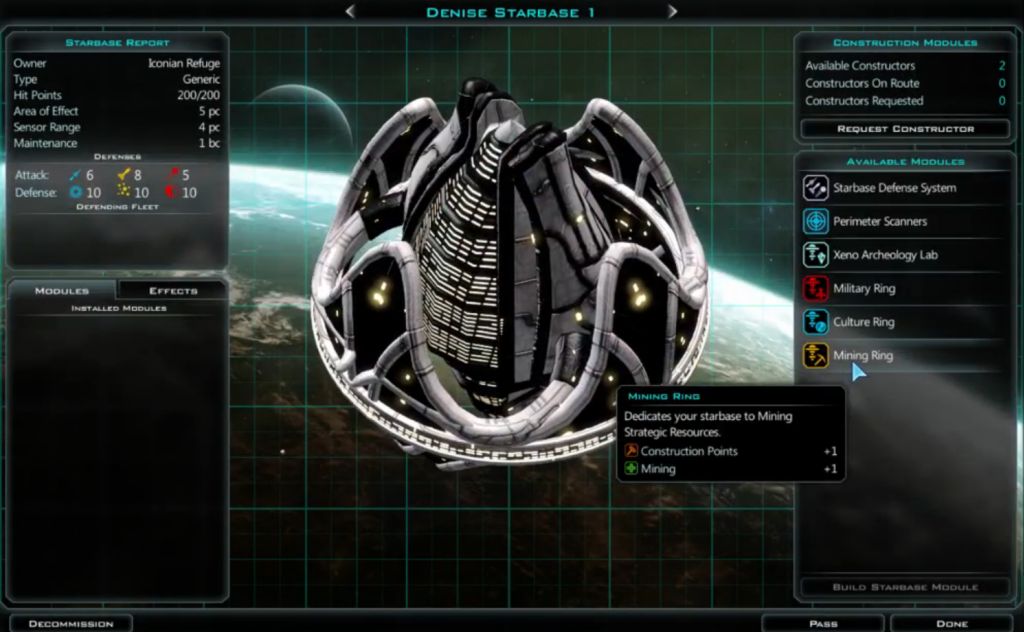
When a starbase is first constructed, the builder must designate a type: mining, economic, cultural, or military. I think those are the only four types, I might be missing something though. When a starbase first appears, the builder picks a type and can construct one "module" depending on that type. For example, a mining startbase will select the mining module and start providing quantities of resources. I have the mining module highlighted in the above picture. But mining starbases aren't the only type possible; you can build economic starbases next to your planets to provide them with various bonuses from orbit (production, morale, wealth, etc.) This is especially nice to do in systems where a bunch of planets cluster together and can all be boosted by a single starbase. Then there are cultural starbases that push your influence out onto the map, expanding borders and potentially even flipping enemy planets if your influence is strong enough. These are useful to build in empty regions of the map. Finally, there are also military starbases, although I'm not sure exactly what purpose they're designed to serve. I believe they provide combat bonuses to friendly ships nearby, which I could see being helpful in the right circumstances. I've never built one of them yet.
Starbases get one initial starting module from the constructor that built them. However, they can be upgraded again and again with more modules over time. In fact, a huge portion of the Engineering tech tree is devoted to nothing more than starbase upgrades for the mining and economic starbases. With enough research, you can wind up with some crazy tricked-out starbases in the lategame! The cost is that each additional module requires another constructor for the upgrade, which means that lots of starbases require a lot of shipbuilding production. After the expansion phase of the game is over, I've often found the homeworld building nothing but constructors for long stretches of time. Another starbase is always useful, and current starbases can always be upgraded with more advanced modules. You can also design ships to have multiple constructor units on board, with one ship upgrading a starbase with two or even three modules at a time. The whole starbase concept is practically a minigame in its own right. The downside: managing constructors and starbases can be extremely tedious and time-consuming. This is yet another reason why I sugges playing on smaller maps where the number of starbases is more reasonable.
Three other quick notes about starbases. Number one, starbases can't be built within five tiles of an existing starbase, the only restriction on their placement. There's still room enough for more of them than you could ever build on the map; their limiting factor is constructor production, not available space. Number two, starbases do cost money to support each turn, although I've found them to be pretty cheap. You can spam a lot of them without worrying about it too much. Number three, starbases extend your ship range in the same way that a colony does. This is another reason why they're nice to have, as simple range extenders into other parts of the map. Nothing is worse than an armed fleet that doesn't have enough range to reach the target. Throw down a starbase near the front and the problem is solved. (Just be careful - starbases can be destroyed!)
Let's go back to that map from before:

At the bottom of the screen, I found a new planet called Kane just to the northwest of Krynn space. At PC9 and with bonuses to social spending and tourism, that was a sweet spot to grab. Unfortunately, there was a Krynn colony ship only four tiles away, so I had no chance of landing this world, right? Well, not so fast - maybe I did have a chance! I had already built a colony ship for the weaker PC5 planet near the northern pink star, and that colony ship was already en route when I discovered the Kane system. It's the little ship icon just about to leave my borders to the southwest of the homeworld. Now I've already moved the colony ship this turn, but my version of this design gets 8 moves per turn. Meanwhile, the silly AI only has 2 moves on the Krynn colony ship. It's going to take them two more turns to reach that planet. I can move at the start of next turn, watch the Krynn move two tiles on their turn, and then move again on the following turn. As luck would have it, my colony ship had just enough movement to swipe the Kane system out from under the Krynn's noses! Tough luck for the AI. Ah, but it gets worse for them. That slow-moving Krynn colony ship can't even fall back on the PC5 world to the north, because by the time it arrives I'll already have built another colony ship of my own and routed it down there. I would clean up both planets, leaving the Krynn with nothing. 
This is a great example of one of the AI's serious weaknesses: they do not emphasize enough speed on their ships. On the highest difficulties, the AI gets ridiculous production bonuses, and they're always shuffling around with more colony ships than they know what to do with. However, they use inefficient designs that have only one engine module present, while a smart human player will stack as many engines as they can get away with. The AI will also do this with warships, loading them down with weapons but only getting 2 or 3 moves each turn for their fleet. If I'm faster than they are, I can dance around their ships all day, picking when and how I want to engage in combat. My poaching of planets at Gambit and Kane illustrates the benefits of speed. It doesn't matter how many production cheats the AI might have if my colony ships can move four times faster than theirs!
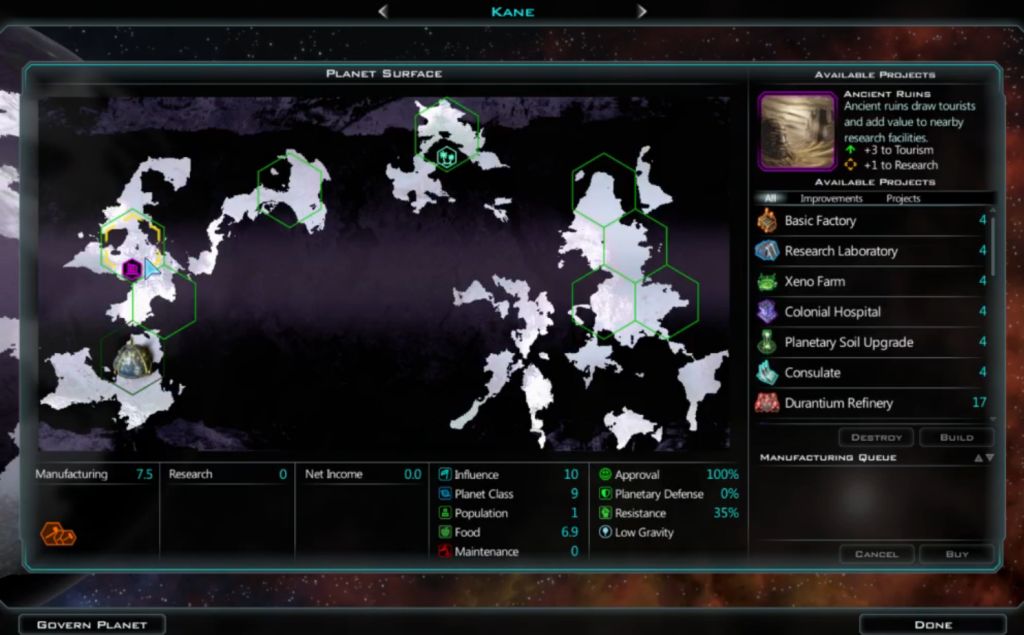
Here's a picture of the surface of Kane, to get an indication of what a new planet looks like. When developing a new colony, I suggest starting out with factories before anything else. This is pretty obvious in terms of logic: if you're going to add a bunch of infrastructure, do the thing that speeds up the construction of the rest of the infrastructure first. A key question is how many factories to add, and that depends on the world in question. For non-production worlds, I'll go with either 1, 2, or 3 depending on the planet quality. The more tiles available to build upon, the more you can afford to tie up with factories. Two factories seem to be a nice number for your "average" planet in the PC7 to PC12 range. If placed next to each other, two factories grant +60% production, and that's enough to build infrastructure in a reasonable time frame. Only the really high quality planets can afford to tie up more tiles on factories if they're not being specialized for production. Conversely, tiny planets have to make due with only a single factory, or none at all in extreme cases. Production worlds like New Iconia don't have this restriction, of course, and can lay on factories early and often. Just be careful not to overdo the number of production worlds; I've found that you don't seem to need that many, and production worlds tend to be useless at doing anything other than shipbuilding. Anyway, every planet needs at least a handful of factories. Takes absolutely forever to build anything if you try to go with zero factories.
After the factories are done, I will typically try to get a hospital/farm pair up next. As I mentioned before, I strongly suggest putting a hospital on every planet for the growth bonus. Farms provide an adjacency bonus to hospitals, and vice versa, making them a natural pair. Unlike hospitals, farms are not unique and the player can put as many of them on a planet as desired. However, more than one farm tends to be a waste of tiles because there won't be enough morale to keep all those extra people happy. (And of couse, by putting a farm down you're increasing the population cap on that world, but you're not using the tile to get some other bonus to production or research or whatever.) I will therefore typically assign two tiles for factories, two tiles for the hospital/farm pair, and at least one tile for a morale building of some kind, sometimes two tiles. With the colonial capital eating up a tile as well, that's roughly 6 or 7 tiles for the basic planetary infrastructure, leaving the remaining tiles to emphasize whatever the planet is specializing in. This is a great example of why higher PC planets are so much more desirable; a PC8 world needs to use almost all of its tiles for the basic infrastructure, and can put down maybe 1 or 2 research labs. A PC12 world should be able to get 5 or 6 of them! Thus a PC12 world isn't just 50% better as a research planet, it's going to be more like 100% better after all the modifiers from the additional buildings are tallied up. High PC worlds = awesome.
Since we've been discussing morale, let's look at this issue in more detail:
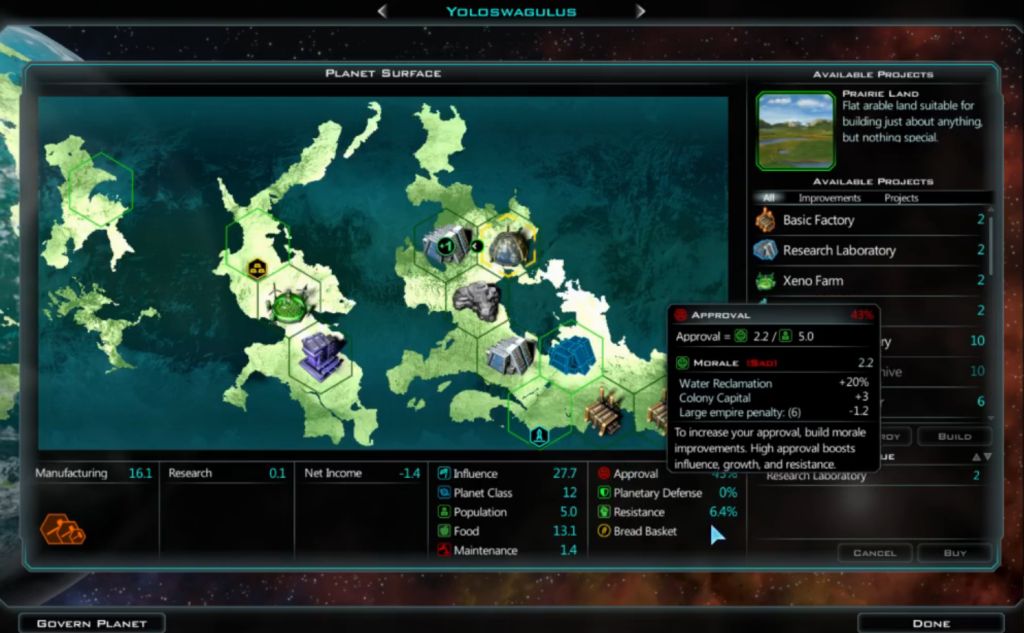
This is the Yoloswagulus colony, still in the middle of its development. I built the two factories first down in the southeast corner, then the hospital/farm pair on the central continent. I'm in the process of filling out some research labs in the remaining slots, putting them next to the gray rock thing (a resource) because it provides an adjacency bonus to research labs. However, there's a major problem here: the morale of this colony is terrible!  The formula for morale is a simple percentage, the population of the colony divided by the current morale rating. Right now, Yoloswagulus is under 50% morale, and that's bad. Low morale has several different negative effects, with growth being foremost among them. Your colonies grow at a slower rate when they suffer from low morale. The lower the morale, the slower the growth rate. Growth is 25% slower at 0% morale, and I personally feel like the penalty should be even harsher. Conversely, high morale carries a growth bonus, up to 25% faster at 100% morale. That's like getting another hospital for free! Given the importance of population and the slow rate of growth in GC3, trying to keep your planets near 100% morale is a very big deal. But morale doesn't just affect growth, it carries a bonus/penalty effect on influence, invasion resistance, and production as well. Like the growth rate, reaching 100% morale will cause influence to grow 25% faster, while sitting at 0% morale will cut influence and production by 25%. Those percentages add up in a big way over time. Trust me on this: you want high morale if at all possible.
The formula for morale is a simple percentage, the population of the colony divided by the current morale rating. Right now, Yoloswagulus is under 50% morale, and that's bad. Low morale has several different negative effects, with growth being foremost among them. Your colonies grow at a slower rate when they suffer from low morale. The lower the morale, the slower the growth rate. Growth is 25% slower at 0% morale, and I personally feel like the penalty should be even harsher. Conversely, high morale carries a growth bonus, up to 25% faster at 100% morale. That's like getting another hospital for free! Given the importance of population and the slow rate of growth in GC3, trying to keep your planets near 100% morale is a very big deal. But morale doesn't just affect growth, it carries a bonus/penalty effect on influence, invasion resistance, and production as well. Like the growth rate, reaching 100% morale will cause influence to grow 25% faster, while sitting at 0% morale will cut influence and production by 25%. Those percentages add up in a big way over time. Trust me on this: you want high morale if at all possible.
The colonial capital provides 3 morale to start out on each world, then the player has to supply morale after that. Note the glaring penalty that I'm suffering under here: -1.2 morale for "Large empire penalty". This is the way that GC3 tries to reign in expansion, by creating a morale penalty for colonizing additional planets. It's this game's version of the maintenance costs from Civ4. The Large Empire penalty is exactly -0.2 morale per planet in your empire, a pure linear relationship which does not change according to map size. (This causes some bizarre results on the largest map sizes, and the designers need to look into scaling this mechanic by map size in some way.) Now the player isn't going to stop expanding just because of this penalty - more planets are always better to have! - but it does mean that morale bonuses become extremely important. Solving the morale dilemma is typically the second phase of a game of GC3. The first phase is the expansion phase, a mad rush to colonize as much as possible before the AIs take it for themselves. Once you've grabbed whatever you can get, your colonies will be suffering from the "Large empire" morale penalty, and fixing that becomes the second phase of the game. That means teching to Xeno Commerce for entertainment centers (or something similar depending on each race's tech tree), trading for morale resources, building starbases on morale relics, etc. Anything at all to pick up additional morale stuff. This is another reason why I favor the Benevolent and Malevolent ideologies, as both of them have policies that grant additional morale buildings. Pragmatism doesn't seem to have much in the way of morale bonuses, and that's a tougher route for sure.
I've been reading posts on the GC3 forums from people who insist that morale is pointless. There are a lot of voices arguing that the player should ignore morale completely, accepting the penalties of 0% morale and not investing any resources into trying to increase happiness. They may even be right - for the ridiculously huge map sizes that all these people seem to be playing on. Yes, the balance of the Large Empire Penalty is badly off when playing on the Insane map size with 1000 stars and 100+ planet empires. What did you expect? I probably wouldn't care about morale under those conditions either, since the non-scaling Large Empire Penalty is set too high. But for anyone playing on a more normal map size, ignoring morale is a terrible idea. Sitting at 0% morale as opposed to the maximum carries a penalty of -50% production, -50% growth, -50% influence, and -50% resistance to invasion. Not good at all. I'll happily use up one planetary tile to get the benefits of 100% morale, thank you very much!
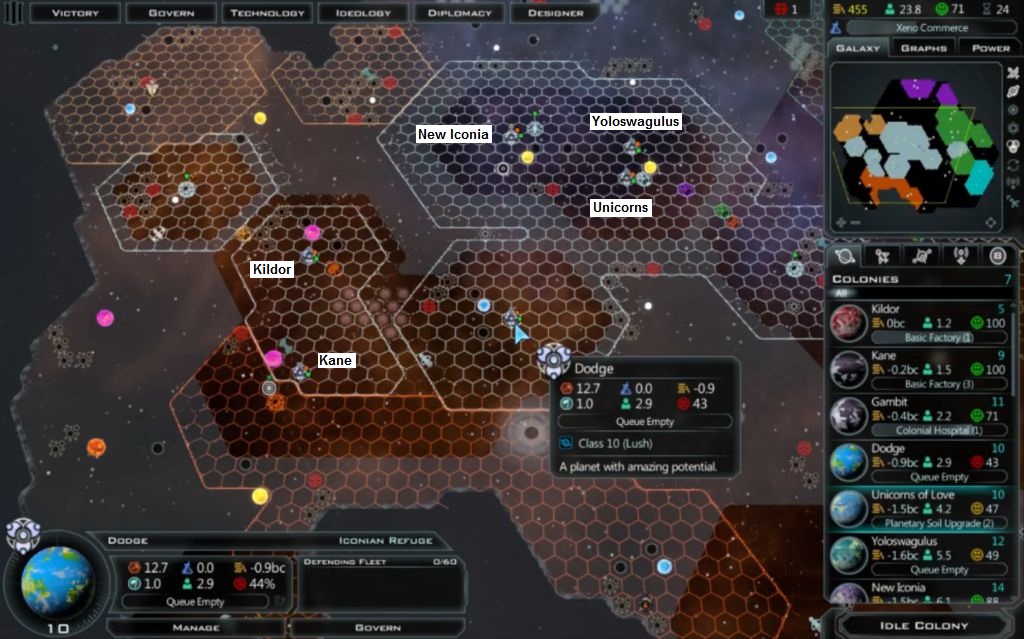
Here's the situation 25 turns into the game. I wound up with seven colonies, which would form my core worlds for this game. I was extremely pleased with what I managed to land, especially the Kane and Gambit systems. I had close borders with the Krynn, the Iridium Corp, and the Thalans over at Gambit. Beyond them were the Yor in the north, the Altarians in the southeast, and the Drengin in the deep south. I had spawned near the center of this galaxy, with rival empires on every single side. There would be no safe backlines in this game, and every planet was potentially under threat. Truly I was surrounded on all sides.
The landgrab was largely over, but the game itself was just beginning.



